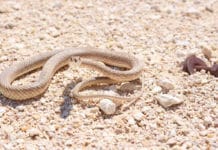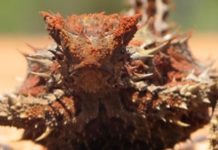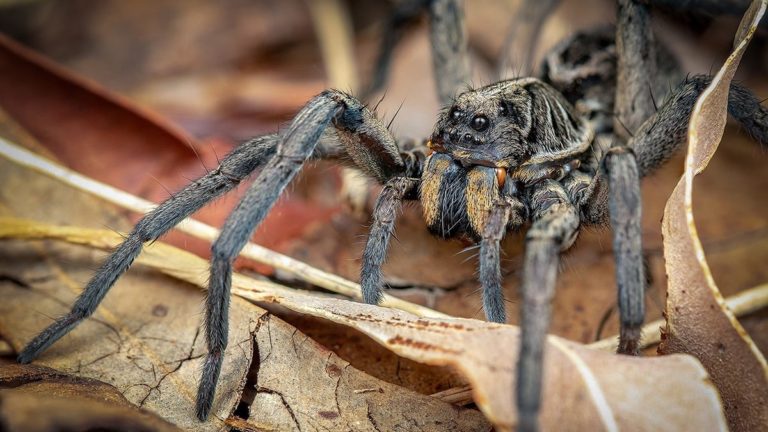
Australia is renowned for its diverse and unique wildlife, and its spider population is no exception. With over 2,700 species, spiders in Australia range from harmless garden dwellers to some of the most venomous species in the world. This ultimate guide will explore the fascinating world of Australian spiders, their habitats, behaviors, and the myths and facts surrounding them.
Table of Contents
Are spiders in Australia dangerous?
Many people associate Australia with Spiders and many people avoid this beautiful country due to the fear of their venomous bite. However, no mortality has been registered due to a spider bite in Australia since 1979. There was one suspicious death following the bite of a Redback spider back in 2016 but the circumstances remain unclear as to the treatment that followed.
In fact, of approximately 10,000 species present in Australia (around 2700 officially described) only a few families of these spiders are potentially dangerous to humans. The two most problematic groups are those commonly known as the Funnel web spiders (which includes 3 kinds of spiders) and the Redback spiders. Then come the Mouse spiders who can also cause serious envenomations although a bite has never been lethal.
The vast majority of spiders are in fact harmless. It is known as a “dry or blank bite” when a spider bites but does not inject venom.
Where to find spiders in Australia?
Australian spiders are highly adaptable, thriving in diverse environments from urban settings to the wild Outback. Due to the diversity of arachnids in the country, you can find spiders everywhere in Australia. Some families, however, are more localised than others. Although, depending on their way of life there is still very little chance of crossing them.
The funnel web spiders prefer temperate and humid climates and they live most of the time in burrows. In Australia they are only found in the southeastern part of the country, from South Australia to Queensland via Victoria, New South Wales and Tasmania. You won’t find them in the dry and arid zones.
On the other hand, huntsman and wolf-spiders are found all over the country. They like to wander at night, so this is when you are most likely to cross them. Redbacks also adapt to many climates. They never leave their canvas and generally weave them in dry areas, away from daylight.
Spider Season & Climate
| Region | Peak season | Why? | Curious 2025 fact |
| NSW coast | Nov–Feb | Warm & humid, perfect hunting | 2024 “Ballooning Day”: millions of spiderlings spun silk, creating “spider snow” near Goulburn |
| Outback NT | Mar–May (post‑rain) | Insect boom | Camel researchers found 3 spider species hitchhiking on dromedaries |
| Tasmania | Mild all year | Little frost | First jumping spider with antifreeze protein discovered 2025 |

The diversity of Australian spiders
Australia’s spiders come in all shapes and sizes, inhabiting various environments from urban areas to the vast Outback. Here are some of the most notable species:
Funnel Web spider
The funnel web spiders are native of Australia, they belong to the family of Atracidae which includes 3 genera. The 2 most infamous (and the most dangerous) belong to the genus Hadronyche (31 species) and Atrax (3 species). These two genera contain the most dangerous species of spiders. By a curious chance of evolution, their venom is particularly active on primates. Interestingly, they are almost harmless to mammals like dogs or cats.
The most dangerous of these species is the Atrax robustus, known as Sydney funnel web spider. As the name describes, this species lives more or less within a 100 km radius of Sydney. Recognizable by its shiny black carapace and aggressive nature.The venom of the male is about 5 times more toxic than that of the female and during the spring and summer, the males leave their shelters in search of a female during the night. That is why many people in Sydney’s suburbs find them in and around their homes at this time. They can even survive in water, often up to several hours if they inadvertently fall into a pool for example. Atrax robustus spiders were to blame for 13 deaths prior to the invention of antivenom in 1980. 30 to 40 bites are recorded each year for funnel web spiders and yet only 100 anti-venom injections have actually been necessary since its creation.
Fun extra 2025: Thanks to the Funnel‑Web Challenge program, Sydney residents now hand in more than 5,000 spiders each year to the Australian Reptile Park, producing 1,000+ doses of antivenom – a new 2024/25 record.
K’gari (Fraser Island) Funnel‑Web
- Fact: Newly classified in 2022; lives in sand – unique among funnel‑webs.
- Fun extra 2025: First field study shows its venom is less toxic to humans than the Sydney species – good news for beach campers.
Habitats
These spiders prefer moist, dark places like forest floors. Their habitat differs depending on the species. The burrow can be found on a decaying tree for example, but also found on the edge of a rock on the ground. The spider forms a kind of silk funnel usually surrounded by streaks that serve as “alarms” so when prey lands, they vibrate, alerting the spider that lunch has arrived. Note that other types of spiders such as Trapdoor spiders also use funnel burrows for this reason.
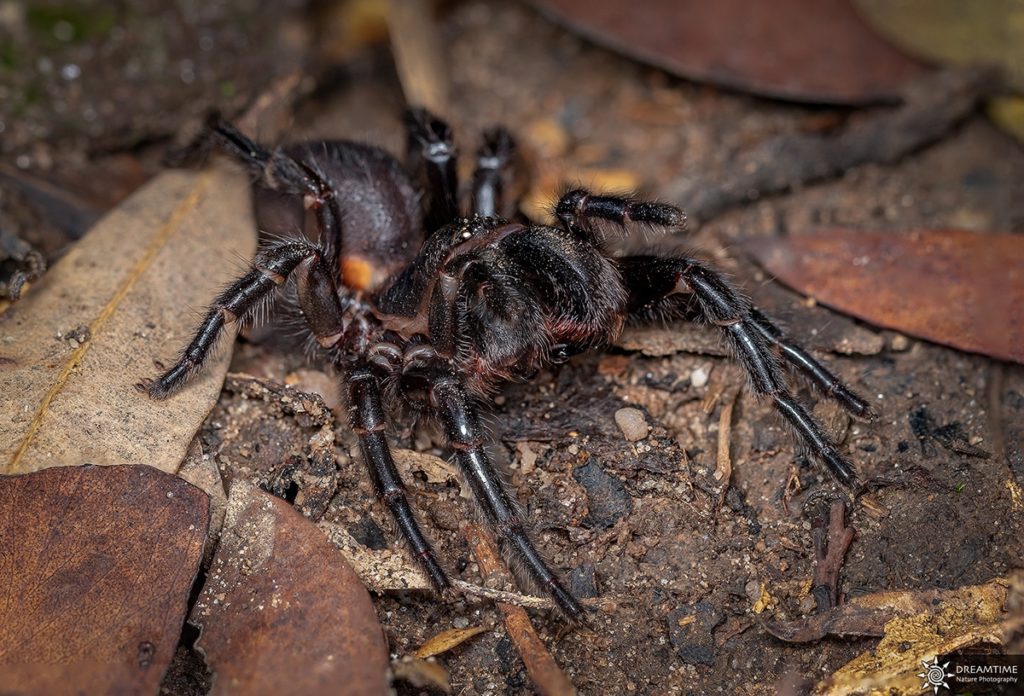
RedBack
The Redback (Latrodectus hasselti) is somewhat of an Australian icon! There are about 2000 Redback bites reported every year. Even though she possesses a very powerful venom with a lot of unwanted and painful symptoms, there have not been direct and proven moralities following a bite for a very long time. Antivenom has been around since 1956. Note, only females are dangerous, males are much smaller and even if they have venom they are considered harmless.
The Redback belongs to the genus Latrodectus, which includes a multitude of species around the world including the American black widow. There is even a species present in Europe known as the Mediterranean black widow or the Malmignate (Latrodectus tredecimguttatus) as it is known in Europe.
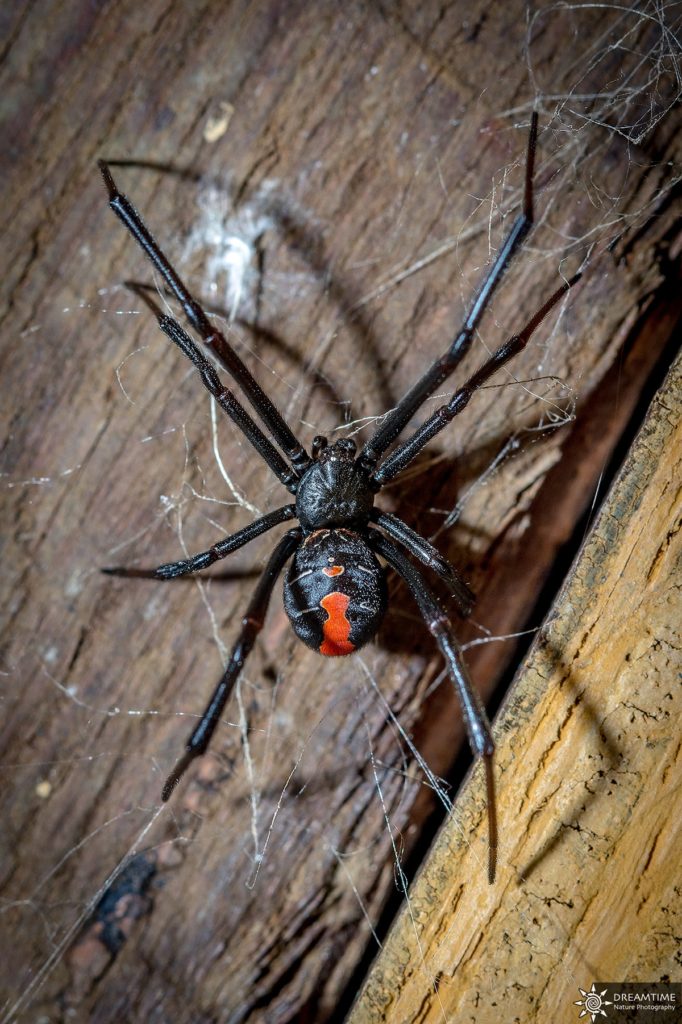
Fun extra 2025: CSIRO is testing a bio‑pest gel that uses male pheromones to lure females out of garages – commercial release expected 2026!
Habitats
They can be found in most Australian terrain though prefer to weaves their canvas in hidden and protected places. That’s why they are so common around homes and are most likely to be seen indoors. They are particularly fond of the dark corners of garages, attics or outside homes. These spiders are nocturnal so will stay sheltered at the bottom of their nest during the day then patiently stay on their web while waiting for the arrival of prey at night.
Characteristics
Females are small black or dark brown with a very distinctive red-orange line on the back of the abdomen. They also have an orange-red mark on the ventral part of the abdomen. Young females are brown instead of black and in addition to the red line, they may also have white lines on the abdomen but as they age, this turns black and the white lines disappear.
Huntsman Spider (Family Sparassidae)
Hunstmans are the nightmare of all arachnophobes in Australia. This is because they can be extremely large depending on the species and have very long legs. Their venom is not dangerous to humans but because of their size, the bite can still cause local pain and swelling.
Despite their size, they are not aggressive and will only bite to defend themselves if provoked.

Habitats
The Huntsman is found all over Australia. They are nocturnal and spend all day hidden in crevices, behind the bark of the trees or in the dark recesses in houses. At night, they come out of their shelters to start hunting.
Characteristics
The leg length of these spiders are disproportionate to their body – heightening their alarming appearance. Depending on the species, they can be brown, grey or greenish shades! The largest specimens are found on the east coast, and some can reach about twenty centimetres from one end to another!
Species like the Huntsman and Wolf spiders actively hunt their prey, using speed and agility rather than webs.
White tailed spider & Daddy-long-legs
In Australia, white-tailed spiders (Lampona cylindrata and Lampona murina) are considered dangerous. It is believed that their venom could induce skin infections such as necrosis. On the other hand, however, more and more studies tend to prove that there is no direct link between the venom of its spiders and the possible reactions following bites. Although they may be impressive and a popular belief surrounds them about being dangerous they are actually extremely rare.
Finally, the biggest urban legend about spiders in Australia, the so-called danger of “Daddy-long-legs” spiders (Pholcus phalangioides.) It is believed, that they are the most venomous of all spiders, simply because they feed on the Redback! These are the famously common spiders that can be found in the corners of most homes around the world, but are in fact harmless to humans. The fangs of this spider are incapable of piercing human skin. In fact, they are handy to have in your home as they are your biggest allies against mosquitoes!
Fun extra 2025: The BiteSnap app now uses AI image analysis to identify white‑tail bites with 93 % accuracy (Monash University study).
Common (but Harmless) House Guests
| Species | ID tip | Helpful because… | Extra twist 2025 |
|---|---|---|---|
| Huntsman | Huge span, up to 30 cm | Eats cockroaches | 2024 viral star: Huntsman “Charlotte” slept 6 weeks behind a backpacker’s TV, 4 M TikTok likes |
| Golden Orb‑Weaver | Gold‑tinted silk | Traps mozzies & moths | New 2025 material patent: silk 5× tougher than Kevlar |
| Daddy Long Legs | Long legs, tiny body | Cleans out redbacks | Urban myth poisonous? Nope – weak venom & short fangs |
| Jumping Spider | Colourful eyes, jumps | Eats flies | 2025 discovery: “Peacock Jumper” fluoresces under UV |
Safety tips
Keep in mind that Redbacks can also be very common in some places. Do not panic, however, as bites are rare. If by chance you are bitten by one of them and you think you are a victim of envenomation, seek medical help immediately and you will recover quickly. Note, like most medical expenses in Australia, this kind of treatment can be very expensive for a simple bite so for this reason (and many others) ensure you have travel insurance before your trip!
How to avoid the risks ?
Spiders are not aggressive by definition. If they attack, it is because they feel in danger. This means that if you don’t go and annoy them on their web, on their tree or in their burrow, they will certainly not want to approach you. However, it is preferable to always be careful to where you put your feet or slide your hands.
Some advice to follow
- Shake out shoes and clothing that have been left outside before putting them on.
- When emptying and filling your backpacks, shake them out first
- If you work on a farm, in a garden or in shed, always wear thick gloves
- Avoid sticking your hands in corners before checking that there was nothing there first
- Leave your sun visors open if you are afraid of a spider getting inside your car.
Keep Calm & Crawl On
Your odds of being bitten by a dangerous spider are < 0.001 % – lower than winning the lottery. With a bit of commonsense and these tips, you can safely admire Australia’s eight‑legged locals.
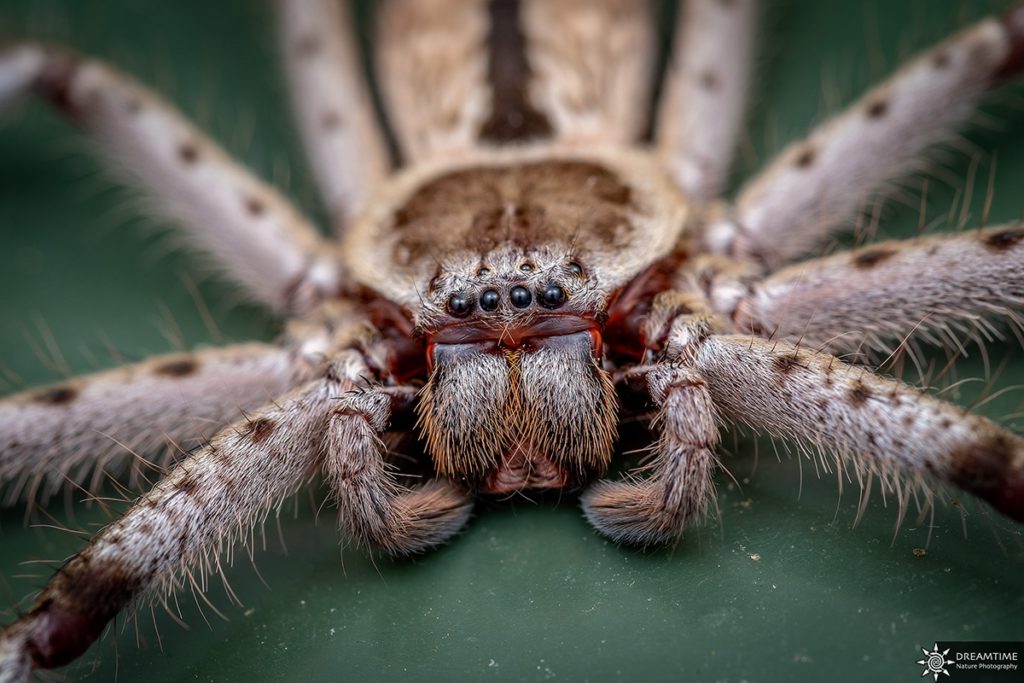
What to do in case of a bite?
In case of a bite, you may see redness on your skin for up to 24 hours afterwards, with itching or irritation.
- Disinfect the bite area
- Apply ice to prevent redness and swelling
- If in doubt, go to the pharmacy
- If symptoms appear (acute pain, fever, aches) go to the emergency room or to the doctor straight away. If bitten, try to identify the spider and seek medical attention promptly. Antivenom is effective for treating bites from species like the Funnel-Web and Redback.
Do you think you know now everything important? Try our ultimate Spider Quiz here
Myths and Facts about Spiders
Australia’s reputation for dangerous spiders is often exaggerated. Here are some common myths debunked:
- Myth: All Australian spiders are deadly.
Fact: While Australia has some venomous spiders, the majority are harmless to humans.
- Myth: Spider bites are common and often fatal.
Fact: Serious spider bites are rare, and fatalities are even rarer due to effective antivenoms and prompt medical treatment.
- Myth: Huntsman spiders are highly aggressive.
Fact: Huntsman spiders are generally timid and more likely to flee than attack.
Swallowing spiders in your sleep? Myth – no study supports it.
Deadliest in the world? That’s the Brazilian wandering spider, not the redback.
Pet huntsman: Perth’s 2024 “Arachnarium Café” lets guests sip coffee while hand‑feeding tame huntsmans – yes, really.
Sources: https://australianmuseum.net.au/ / https://www.csiro.au/





















